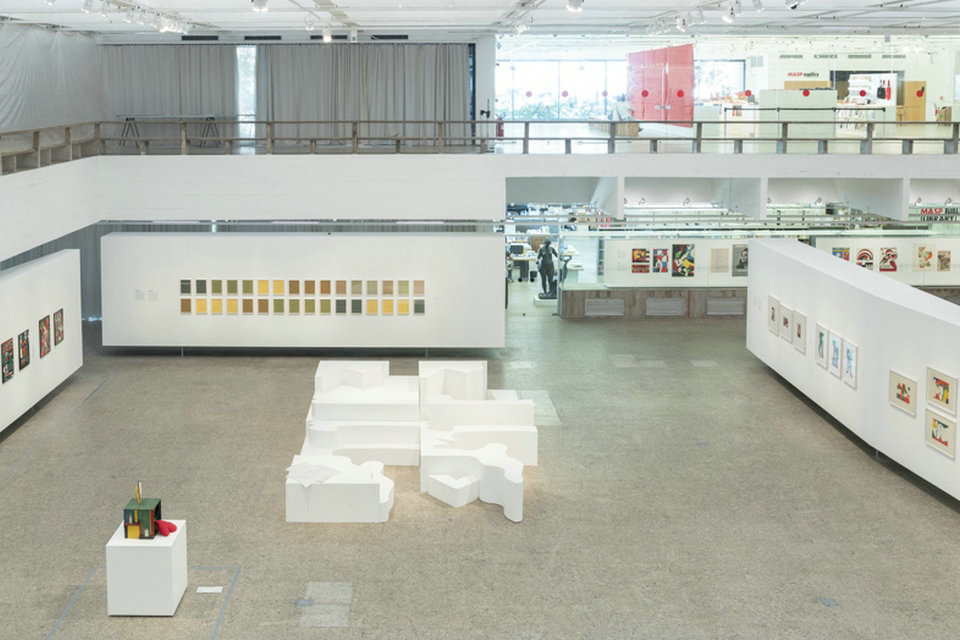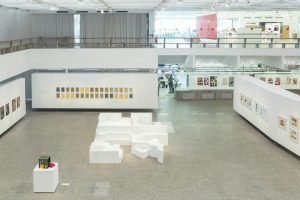Who´s Afraid of Teresinha Soares? MASP presents a retrospective of Teresinha Soares, a pioneer in the thematics of female gender identity. Quem tem medo de Teresinha Soares? will occupy the museum 2nd sublevel with paintings, drawings, prints, box-objects, reliefs and installations, as well as photographic documentation about the artists pioneering happenings and performances. The show will shed light on the little-known production of one of the most questioning and controversial Brazilian artists of the 1960s, who in that period was widely reported in the mass media.
A powerful and emancipated personality, a writer and defender of womens rights, Teresinha Soares rounds out her biography by being the first woman ever elected to the city council of the city of her birth, as well as a beauty pageant winner, a public worker and a professor.
With more than 50 artworks by Teresinha Soares (Araxáˇ, Minas Gerais, Brazil, 1927), from her intensely productive period spanning from 1965 to 1976. This will be the first extensive overview of Soares production ever held in a museum, in Brazil or abroad, and will also be her first large solo show in more than 40 years. The title of the show alludes to the celebrated play Who´s Afraid of Virginia Woolf? by Edward Albee, and refers to the behavioral taboos that the work of Teresinha Soares confronts by being counterposed to the machismo of both society and the art world.
A pioneering artist in regard to the treatment of themes of gender, such as female sexual liberation, violence against women and gender equity, Soares also made works that dealt with political issues, as in the series of paintings Vietnam (1968), in which she presents an original and irreverent approach to the theme. The representation of the body is one of the most recurrent motifs in the artist’s oeuvre, encompassing a range of aspects spanning from birth to death, and the relationship with nature.
In the work Eurotic (1970), consisting of an album of silkscreen prints made based on line drawings and printed on differently colored sheets of paper, a variety of posture is configured on the basis of combinations of bodies and different interactions. Based on those drawings, Soares developed Body to Body in Colour-Pus of Mine (1971), her first large installation, which represents a milestone in her career. Open to participation by the spectator, this artwork is composed of four modules of different heights, made of white-painted wood, like a raised stage in a sinuous shape that occupies 24 square meters of space. On opening day, a performance will be held to inaugurate the work, just like the one Soares carried out in the Grand Salon of the Museu de Arte da Pampulha, in 1970, with the participation of dancers and the narration of a text recorded by her.
Although it is possible to relate Soares work with some trends from the 1960s, such as global pop art, nouveau ralisme and the Brazilian new-objectivity movement, the artist always resorted to an artistic language that was both spontaneous and personal. Even today, her work is little-known to the Brazilian public at large, despite that Soares participated actively in the art circuit for ten years, holding exhibitions in galleries, salons and biennials. Currently, she has been increasingly participating in international exhibitions that contextualize her in the ambit of the new figuration movement of the 1960s, as well as in political art: The EY Exhibition: The World Goes Pop (Tate Modern, London, 2015), Arte Vida (Rio de Janeiro, 2014) and Radical Women: Latin American Art, 1960-1985 (Hammer Museum, Los Angeles, 2017).
For the exhibitions curator Rodrigo Moura, is today, as her work is beginning to garner more recognition both in Brazil and abroad, an exhibition that takes a close look at her career and analyzes the evolution of her artistic language contributes not only to this recognition, but also toward understanding the mechanisms and the methodologies that informed a feminist practice in the Brazilian context of that period.” Adriano Pedrosa, MASP’s artistic director, comments on the show´s relevance: it is a privilege for MASP to present the first general overview of the artists oeuvre. The museum thus fulfills a crucial role: that of presenting to the public at large a work which should be considered and reinscribed in the recent history of Brazilian art.
Quem tem medo de Teresinha Soares? is being held in the context of the museum programming for 2017 dedicated to the thematics of sexuality. Around the show Histories of Sexuality which will feature artworks from different periods and collections, there will also be a number of monographic exhibitions by Brazilian and international artists whose works raise questions about corporeality, desire, feminism, questions of gender, and other issues. This exhibition by Teresinha Soares, will be followed by solo shows featuring the work, respectively, of Wanda Pimentel, Henri de Toulouse-Lautrec, Miguel Rio Branco, Guerrilla Girls, Pedro Correia de AraĂşjo and Tunga.
Sao Paulo Art Museum
The Museu de Arte de São Paulo (MASP) is a private not-for-profit museum founded in 1947 by business mogul and patron of the arts Assis Chateaubriand (1892–1968), becoming the first modern museum in the country. Chateaubriand invited Italian art dealer and critic Pietro Maria Bardi (1900–1999) to direct MASP, and Lina Bo Bardi (1914–1992) to conceive the architecture and the exhibition design. With the most important collection of European art in the southern hemisphere, MASP’s holdings currently consist of more than 11 thousand artworks, including paintings, sculptures, objects, photographs, videos and pieces of clothing from various periods, from Europe, Africa, Asia and the Americas.
Initially located on the street 7 de Abril, in downtown São Paulo, in 1968 the museum was transferred to its current location on Avenida Paulista, in the iconic building designed by Lina Bo Bardi, which has become a landmark in the history of 20th-century architecture. Making use of glass and concrete, in her architecture Lina Bo Bardi put rough, unfinished surfaces into harmony with aspects of lightness, transparency and suspension. The ground-level plaza under the building’s immense free span was designed as a multipurpose public square.
The architect’s radicality is also present in the glass display easels created to show the collection on the building’s second floor. By taking the artworks off the walls, the display easels question the traditional model of the European museum, in which the spectator is led to follow a linear narrative suggested by the order and arrangement of the artworks in the rooms. In MASP’s spacious picture gallery, the suspended and transparent exhibition design allows the public to engage in a closer relationship with the collection since the visitor can choose his or her own path among the artworks, move around them and see their backs.
Besides the long-term show Acervo em transformação [Collection in Transformation] in the museum’s picture gallery, throughout each year there is a broad programming of group exhibitions and solo shows articulated around thematic axes: histories of sexuality (2017), Afro-Atlantic histories (2018), histories of feminism/women (2019). It is important to consider the plural quality of the term “histories,” pointing to multiple, diverse and polyphonic histories, open, inconstant and unfinished histories, fragmented and layered histories, nontotalizing and nondefinitive histories. In Portuguese, the word histórias can denote either fictional stories or factual histories, narratives that can be personal and political, private and public, micro and macro.
This approach reflects the museum’s new mission, established in 2017: “MASP, a diverse, inclusive and plural museum, has the mission to establish, in a critical and creative way, dialogues between past and present, cultures and territories, through the visual arts. To this end, it should enlarge, conserve, research and disseminate its collection, while also promoting the encounter between its various publics and art through transformative and welcoming experiences.”
The calendar of exhibitions is complemented by the public programs developed by the museum’s mediation team and includes international seminars, lectures held on the first Saturday of each month, the MASP teachers program, workshops, courses in the MASP school, and a program of films and videos. To enlarge and perpetuate the discussion around all this programming, the museum produces a series of publications including catalogs of exhibitions and collections, anthologies of the seminars and lectures, as well as materials focused on special projects such as artwork restorations.


